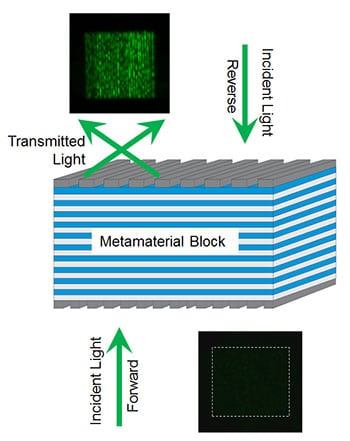Researchers at the National Institute for Standards and Technology (NIST) have developed a new metamaterial made of silver, glass, and chromium that allows for the one-way transmission of visible light.
Metamaterials are artificial materials engineered, combined and structured, often in patterns, to achieve certain properties. Among other functions, certain metamaterials can cloak objects such as tanks or planes from radar,. Metamaterials have also been involved in photonic chips that split or combine signals carried by light waves. This kind of technology has a myriad of potential and exciting applications ranging from defense, public safety, optical communication, and even protection against earthquakes.
In research recently published in Nature Communications, NIST scientists Ting Xu and Henri Lezec have developed a new metamaterial constructed from silver, glass, and chromium that allows visible light to pass through in only one direction, while stopping it from another.
The new light-manipulating metamaterial consists of two nanostructures: a multi-layered block of alternating silver and glass sheets paired with narrowly-spaced metal grates. Taken as the sum of its parts, this combined nanostructure is known as a “hyperbolic” metamaterial, which means that it reacts and transmits light depending on the specific angle and direction the waves are traveling in. Because the device’s miniscule silver and glass layers are thinner than the wavelength of light, visible light can only propagate within the device at certain angles, while being unable to penetrate the device from the outside.

The researchers created this hyperbolic metamaterial via a thin-film deposition technique at NIST’s NanoFab facility. Using computer simulations, they layered 20 silicon dioxide glass and silver sheets only tens of nanometers thick –much thinner than light’s 400-700 nanometer wavelengths – to create the metamaterial block. The scientists then added to the silver and glass a set of chromium grates outfitted with narrow spacings at exactly the right size to bend red and green wavelengths so that they propagate within the block. On the other side of the block, the scientists inserted another set of chromium grates angled in a different direction to guide light out of the structure.
Crucially, this second set of chromium grates was differently-spaced than the first set of grates, bending light either too much or not enough to propagate within the silver and glass layers. After running some tests, the researchers found that about 30 times more light passed through the device than out of it – a ratio that has never been previously recorded.
According to Lezec, “combining materials that could be made using existing methods was the key to achieving one-way transmission of visible light.” The silver and glass layered nanostructure allowed the researchers to complete the project while fabricating and aligning the chromium grates using existing techniques, simplifying the process.
“This three-step process actually relaxes the fabrication constraints,” Lezec said.
This new metamaterial device could potentially be used in novel ways of information processing – for example, in photonic chips that use light instead of electricity to carry and transmit information. In addition, the researchers predict that the device could be used in biosensing devices, as a method of detecting tiny particles, which, like chromium grates, deflect light at certain angles so that they can be noted by a detector from the outside. After running several simulations of the process, Xu hopes to test the idea out soon.
“I think it’s a cool device where you would be able to sense the presence of a very small particle on the surface through a dramatic change in light transmission,” Lezec said.
– Melanie Abeygunawardana






